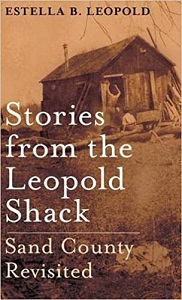
Stories from the Leopold Shack: Sand County Revisited


Peer reviewed research.
Peer reviewed research.
The Center for Invasive Species Management (CISM) developed an online Restoration Resource Database to allow land managers to search for literature, books, handbooks, and web sites on restoration, particularly related to invasive species. CISM is by June 2015 no longer in operation, and the website now serves as an archive of the agency’s projects and resources.
![[Wilding] cover](https://depts.washington.edu/hortlib/graphix/wilding.jpg)
Isabella Tree and her partner, environmentalist Charlie Burrell, own the 3,500-acre property known as Knepp Castle Estate. Her book Wilding: The Return of Nature to a British Farm recounts the Knepp Wildland Project that took place over 18 years starting in 2000 after a failed effort to make the farm profitable with modern, intensive techniques. Their idea, inspired by a similar project in the Netherlands, was to undo many centuries of land management by introducing hardy large herbivores and then stepping back to see what would happen. The author defined it as: “Rewilding — giving nature the space and opportunity to express itself – is largely a leap of faith.” Take a look at a a 15-minute video of Tree introducing the concept.
This book was enjoyable to read because Tree describes various wildlife, birds, insects, mammals, and livestock from an amateur’s enthusiastic perspective rather than with a dispassionate scientific voice. Tree keeps the pace of the narrative moving, yet provides enough details of animals, ecology, history and even governmental regulations that the reader understands why they choose to rewild despite considerable obstacles.
Her narrative of the slow evolution of rewilding their large property takes place over three decades. The story of the farm pasture and woods, neighbors, various national agencies and the wider economy is interspersed with detailed accounts of rare birds, land-use history, heritage breeds of livestock, and the inner workings of ecological interdependence. Tree’s special fondness for the turtle dove is appropriate: nearly extinct in Britain, it is thriving at Knepp.
The role of plants is integral to animal habitat. Tree learns that animals, specifically large herbivores and predators, directly contribute to remaking plant communities which then evolve to support even more species of wildlife. Their philosophy could be boiled down to: increase biodiversity, stay hands-off, build resiliency — repeat!
Neighbors and their notions of a tidy, well-cared-for, pastoral landscape proved to be the most vociferous opponents of allowing their land to revert to a wild state. Tree attempts to understand their unease by looking into the social and psychological impact of living in a controlled, tidy, managed environment. Neighbors saw the Knepp project as abuse and gross negligent abandonment. The author remarks how the oldest neighbors remember the hedgerows and all the birdsong now absent in the agriculturally productive countryside. She also repeatedly points out how their land is marginal and even with modern equipment, chemicals and “improved” breeds they could never make a profit. She wonders why farmers, and governments through subsidies, spend so much on producing food when so much of it wasted, thrown away, uneaten by consumers or worse, never even making it to market because of the low prices received for commodity crops.
Readers interested in regenerative agriculture, ecological restoration and climate change mitigation will find Wilding an inspiring source of hope.
Published in the Leaflet, June 2020, Volume 7, Issue 6.
A list of the best books, theses,articles and websites on restoration ecology.
a list of the best books, articles and websites on wetlands.
“The Society for Ecological Restoration – Northwest Chapter (SERNW), a private non-profit organization, is a dynamic interactive professional society dedicated to the art and science of restoration. Members of SERNW are actively protecting and restoring ecosystems throughout the Cascadia bioregion which includes Washington, Oregon, Montana, Idaho, Alaska and Northern California.”
“The Urban Naturalist is a peer-reviewed journal that publishes original articles focused on all aspects of the natural history sciences as they pertain to urban areas. Subject areas include, but are not limited to, field ecology, biology, behavior, biogeography, restoration ecology, wildlife and fisheries management, taxonomy, evolution, anatomy, physiology, geology, and related fields as they occur in urban settings.”
“Urban Habitats is an open-access electronic journal that focuses on current research on the biology of urban areas. Papers cover a range of related subject areas, including urban botany, conservation biology, wildlife and vegetation management in urban areas, urban ecology, restoration of urban habitats, landscape ecology and urban design, urban soils, bioplanning in metropolitan regions, and the natural history of cities around the world.” Urban Habitats will become Urban Naturalist. The Urban Habitats site will remain available for past journal issues.